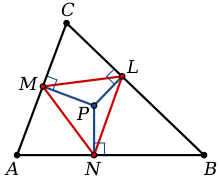Erdős–Mordell inequality
In Euclidean geometry, the Erdős–Mordell inequality states that for any triangle ABC and point P inside ABC, the sum of the distances from P to the sides is less than or equal to half of the sum of the distances from P to the vertices. It is named after Paul Erdős and Louis Mordell. Erdős (1935) posed the problem of proving the inequality; a proof was provided two years later by Mordell and D. F. Barrow (1937). This solution was however not very elementary. Subsequent simpler proofs were then found by Kazarinoff (1957), Bankoff (1958), and Alsina & Nelsen (2007).
Barrow's inequality is a strengthened version of the Erdős–Mordell inequality in which the distances from P to the sides are replaced by the distances from P to the points where the angle bisectors of ∠APB, ∠BPC, and ∠CPA cross the sides. Although the replaced distances are longer, their sum is still less than or equal to half the sum of the distances to the vertices.
Statement

From a point P inside a given triangle ABC the perpendiculars PL,PM,PN are drawn to its sides.
Proof
Let the sides of ABC be a opposite A, b opposite B, and c opposite C; also let PA = p, PB = q, PC = r, dist(P;BC) = x, dist(P;CA) = y, dist(P;AB) = z. First, we prove that
This is equivalent to
The right side is the area of triangle ABC, but on the left side, r + z is at least the height of the triangle; consequently, the left side cannot be smaller than the right side. Now reflect P on the angle bisector at C. We find that cr ≥ ay + bx for P's reflection. Similarly, bq ≥ az + cx and ap ≥ bz + cy. We solve these inequalities for r, q, and p:
Adding the three up, we get
Since the sum of a positive number and its reciprocal is at least 2 by AM–GM inequality, we are finished. Equality holds only for the equilateral triangle, where P is its centroid.
Another strengthened version
Let ABC be a triangle inscribed into a circle (O) and P be a point inside of ABC. Let D, E, F be the orthogonal projections of P onto BC, CA, AB. M, N, Q be the orthogonal projections of P onto tangents to (O) at A, B, C respectively, then:
Equality hold if and only if triangle ABC is equilateral (Dao, Nguyen & Pham 2016; Marinescu & Monea 2017)
A generalization
Let be a convex polygon, and be an interior point of . Let be the distance from to the vertex , the distance from to the side , the segment of the bisector of the angle from to its intersection with the side then (Lenhard 1961):
See also
References
- Alsina, Claudi; Nelsen, Roger B. (2007), "A visual proof of the Erdős-Mordell inequality", Forum Geometricorum, 7: 99–102.
- Bankoff, Leon (1958), "An elementary proof of the Erdős-Mordell theorem", American Mathematical Monthly, 65 (7): 521, JSTOR 2308580, doi:10.2307/2308580.
- Dao, Thanh Oai; Nguyen, Tien Dung; Pham, Ngoc Mai (2016), "A strengthened version of the Erdős-Mordell inequality" (PDF), Forum Geometricorum, 16: 317–321, MR 3556993.
- Erdős, Paul (1935), "Problem 3740", American Mathematical Monthly, 42: 396, doi:10.2307/2301373.
- Kazarinoff, D. K. (1957), "A simple proof of the Erdős-Mordell inequality for triangles", Michigan Mathematical Journal, 4 (2): 97–98, doi:10.1307/mmj/1028988998.
- Lenhard, Hans-Christof (1961), "Verallgemeinerung und Verschärfung der Erdös-Mordellschen Ungleichung für Polygone", Archiv für Mathematische Logik und Grundlagenforschung, 12: 311–314, MR 0133060, doi:10.1007/BF01650566.
- Marinescu, Dan Ștefan; Monea, Mihai (2017), "About a strengthened version of the Erdős-Mordell inequality" (PDF), Forum Geometricorum, 17: 197–202.
- Mordell, L. J.; Barrow, D. F. (1937), "Solution to 3740", American Mathematical Monthly, 44: 252–254, doi:10.2307/2300713.
External links
- Weisstein, Eric Wolfgang. "Erdős-Mordell Theorem". MathWorld.